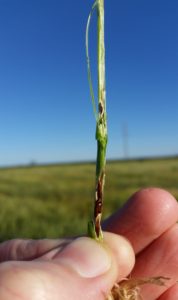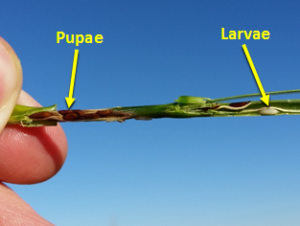by Dr. Clark Neely, Statewide Small Grains Extension Specialist, Texas A&M AgriLife Extension
Dr. Allen Knutson, Extension Entomologist, Texas A&M AgriLife Extension
Hessian fly is a persistent threat to many wheat producersin portions of the Blacklands, the southern Rolling Plains (Concho Valley) and South Texas. Over 70 counties in Texas have reported Hessian fly infestations which can severely impact wheat yields through stunted tillers, lodging and even plant death in severe cases. In 2016, Hessian fly was detected at research plots near McGregor, Brady, and Thrall, TX (Fig 1). Numerous other reports indicated heavy pressure across South Texas . These outbreaks of Hessian fly are likely due to mild winter conditions that allowed high overwintering survival of Hessian fly and the abundance of volunteer wheat due to high rainfall. At this time of year, Hessian fly pupae are found on the stem at the leaf nodes. The leaf sheath must be pulled back down to the node to reveal the pupae. Look for pupae on stunted tillers, those with trapped heads, lodged tillers and green tillers.

Figure 1. Hessian fly pupae (also called “flaxseed”) found in spring 2016 within a hard red winter wheat variety trial near Brady, TX. (Texas A&M AgriLife Extension photo).
If Hessian fly is a major concern in your area or a consistent problem on your farm, now is the best time to start managing for this pest. Hessian fly tends to be worse in continuous wheat rotations, so crop rotation helps to break the life cycle of this pest. This is not full proof however as they can fly a mile or more from neighboring wheat fields or from other host plants. Wheat is the preferred host, but infestations have been found on barley, rye, spelt, emmer, and wild grasses including quackgrass, western wheatgrass, goatgrass and others (Oats are NOT a viable host).
Variety selection is another effective and useful tool. The table below ranks winter wheat varieties based on the number of Hessian fly near harvest. taken in McGregor in 2014 and 2015. A low rating indicates few Hessian flies. Duster and Gallagher are considered resistant to Texas Hessian fly biotypes. The variety Fannin, and those in the table below with a two year rank of 8 or more, are considered susceptible to Hessian fly.
| Variety Rankings for Hessian Fly Resistance
McGregor, TX. 2014, 2015 (Courtesy of S. McLellan & A. Knutson) |
|||
|---|---|---|---|
| Variety | Rank 2014 | Rank 2015 | Two Year Rank |
| Duster | 1 | 1 | 1 |
| Gallagher | 1 | 3 | 2 |
| Cedar | 4 | 2 | 3 |
| Greer | 3 | 6 | 4 |
| 25R40 | 2 | 9 | 5 |
| Coker 9553 | 9 | 3 | 6 |
| Fannin | 6 | 7 | 7 |
| IBA | 11 | 4 | 8 |
| Tam 305 | 10 | 5 | 8 |
| Armour 801 | 7 | 8 | 8 |
| 25R39 | 5 | 12 | 9 |
| L 841 | 8 | 11 | 10 |
| WB 4458 | 12 | 10 | 11 |
If planning to plant wheat in the upcoming year, it is very important to control volunteer wheat and grassy weeds which may serve as hosts and create a green bridge from one crop to the next. Destruction of volunteer wheat will deprive Hessian fly first generation adults of places to deposit their eggs. Tillage and burial of old wheat straw below 4-6” will also reduce adult fly emergence in the fall if the previous crop was heavily infested. While Texas does not have a “fly free” planting date, delayed planting dates can also help reduce fall infestations. Producers planting early for grazing purposes should be aware of the elevated risk for Hessian fly if it is common in their area, and the same is true for several other insect pests as well (See “Managing Insect and Mite Pests of Texas Small Grains”). If planting early with a susceptible variety, seed treatments also help to control fall infestations, such as Gaucho or Cruiser. Read the label for grazing restrictions. These often cost around $7.50 to $13.50 per 100 lb of seed. Burning, baling and removal of residue from infested fields is not considered an effective means of control as pupae on straw at or below the soil surface often remain unaffected.
Two parasitic wasps, Homoporus destructor and Eupelmus allynii, are the most common natural enemies of Hessian fly in Texas. However, these tiny wasps are only active in the spring, after the field is infested, and they do not survive well in low-rainfall areas common in west-central Texas.
Hessian fly larva counts were taken on wheat variety trials in Brady and McGregor, TX in spring 2016. Data will be compiled, summarized and available on the web at http://varietytesting.tamu.edu/wheat later this summer. For more information on Hessian fly please refer to the AgriLife Extension publication “Hessian Fly in Texas Wheat”.

Clark Neely
State Small Grains Agronomist
College Station, TX
cbneely@tamu.edu
